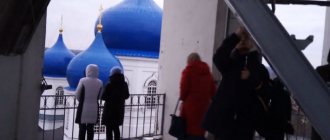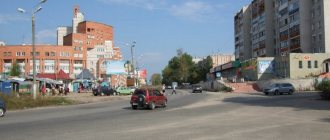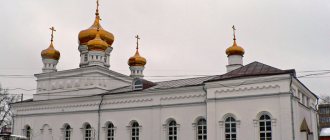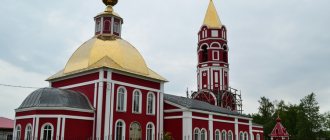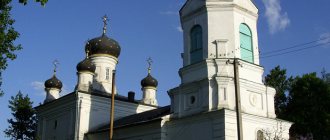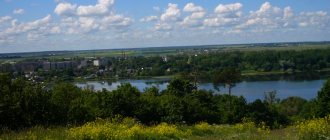Vyazniki
- a city (since 1778) in Russia. Administrative center of the Vyaznikovsky municipal district of the Vladimir region. The center of the urban settlement is the city of Vyazniki. Located on the right bank of the Klyazma River, 93 kilometers east of Vladimir along the M-7 Volga highway.
Population 34,521 people. (2020).
By Order of the Government of the Russian Federation dated July 29, 2014 No. 1398-r “On approval of the list of single-industry towns,” the city was included in the category “Single-industry municipalities of the Russian Federation (single-industry towns) with a stable socio-economic situation.”
origin of name
View of the Klyazma River from the observation deck Nikolai Klodt
. Klyazma spill near Vyazniki
The most common point of view connects the name of the city with the elms that grew in it and in the surrounding area, the Old Russian word vyaznik
meaning "elm forest".
A. A. Tits, referring to one of the handwritten texts, believes that the settlement, and then the city, could get their name from the location “on the ligatures,” that is, on a viscous, swampy place. Finally, folk etymology connects the name of the city with an evil and unjust prince named Kiy
. Once, while hunting on the banks of the Klyazma, he got stuck in a swamp, but did not receive help and died while people shouted “Vyazni, Kiy!”
"Miniature Art Museum"
Lovers of educational recreation will be delighted to visit the village of Mstera, which is located just twenty kilometers from the city. This place has long been known far beyond Russia.
A unique “Miniature Art Museum” has been created here. He will present several exhibitions that you can admire for hours:
- "Embroidery"
- "Painting"
- "Lacquered miniature"
- "Jewelry"
- "Wood carving"
- "Metal products"
- "The Art of Icon Painters"
The friendly museum staff will tell you about each exhibit in an easy and unobtrusive manner.
Story
Prehistory of the city
The most ancient human settlements in the region date back to the Mesolithic era (8-10 thousand years ago), all of their sites Zaborochye, Yakushikha, Kholomonikha were found in the low-lying left bank floodplain of the Klyazma River. Villages of later times are also found on the right bank part, where the modern city of Vyazniki is located, this is the Neolithic era: the area of the Serapion Pustyn churchyard, near the village of Porzamka and the village of Lipovskaya estate, the Bronze Age: Lapino, Bolshiye and Malyye Udoly, Zaborochye and others. The origin of the first settlers is attributed to the Finno-Ugric peoples. By occupation, they were mainly hunters, beekeepers and fishermen, who settled in small tribal communities along the banks of rivers and lakes rich in fish. Over the course of thousands of years, several Finno-Ugric tribes with their own culture were formed on the territory of the Volga-Oka interfluve; the area of the modern city of Vyazniki was located on the territory of the Merya tribe and the Muroma tribe adjacent to it from the south.
From the 4th century AD e. The process of Slavic colonization began. The Slavic tribes of the Krivichi and Vyatichi came from the southwest; the first wave of settlers occurred in the 4th-5th centuries. n. e. and was caused by climatic and political disasters in Europe, the second wave, in the 10th century AD. e., became a consequence of the flight of the Slavs of the pagan faith from forced Christianization. Despite the differences in language and culture, the relationship between the Finno-Ugric and Slavic tribes was quite peaceful, but the culture of the more socially active Slavs gradually began to dominate. Arrival in the XI-XII centuries. Kyiv Slav princes and the subsequent baptism of North-Eastern Rus' led to the fact that part of the Meryan pagan clans went back to the northeast, forming there the Mari tribe (Mari), and part, having adopted the Slavic language and culture, gradually finally assimilated into the newly emerged Russian community. Finno-Ugric roots have been preserved to this day in many names of rivers, lakes and tracts in the vicinity of the city; the origin of some common Russian surnames is also associated with the Mari language.
Yaropolch-Zalessky
The city of Vyazniki traces its history back to the ancient fortress city of Yaropolch-Zalessky, which was located 5 km down the river. Klyazma, in the area of the modern villages of Lapino and Pirovy-Gorodishchi. Excavations have shown the existence of Meryan and Slavic settlements at this site in the second half of the 1st millennium AD. e. as well as traces of more ancient settlements of the Bronze Age of the Volosovo culture. The history of the origin and the cause of the death of Yaropolch-Zalessky are unknown for certain; according to the prevailing version, it was founded by Prince Yaropolk Vladimirovich in 1135-1138. and ceased to exist after being burned in 1239 by the troops of Batu and Subedei. Nevertheless, there are different hypotheses, in particular, a possible reason for leaving such a well-equipped place could be the plague epidemic that took place in Rus' in the middle of the 14th century. The city played the role of a guard outpost on the northeastern border of the ancient Russian state, being part of the so-called Berezhetskaya road, which united the border fortress towns of Berezhets, Gorokhovets, Yaropolch-Zalessky, Starodub-on-Klyazma, and also personified princely power in the region, becoming the center of the Yaropolch volost. After the death of Yaropolch Zalessky, the Yaropolch volost continued to exist, its center moved to the neighboring village of Pirovy Gorodishchi and further west, to the area of the new growing villages of Butyry and Tolmachevo, already located on the territory of the modern city of Vyazniki. By this time, the fortress had already lost its strategic importance; Nizhny Novgorod, which stood at the confluence of the Oka and Volga rivers, pushed the borders of North-Eastern Rus' far to the east.
Yaropolch on Minina Mountain
The new city of Yaropolch was built on the territory of the modern city of Vyazniki in 1657 by decree of Tsar Alexei Mikhailovich; previously, the village of Minino, the patrimony of the boyar Fyodor Mstislavsky, stood on this site. Currently, the hill on which the ancient city was located is called Minina Gora or Barskaya Gora, on which stands the Trinity Church with a bell tower. The construction was led by governor Saturday Semenovich Chaadaev, people from Gorokhovets, Saryev, villages near Suzdal and Murom were involved in the work. The new construction of strong fortifications was caused not by an external threat, but by increased tension within the country associated with the Moscow Troubles of 1648, numerous riots of black people in different cities, with the growing Schism in the Russian Church, which ultimately resulted in a large-scale peasant war led by Stepan Razin .
Yaropolch was a quadrangular earthen city with stone towers at the corners (the village of Minino was renamed Yaropolchsky Gorodok), inside there were most of the courtyards of wealthy Yaropol residents (modern Kiseleva Street), a state barn, a green (powder) cellar, a circle yard, an office and labial (torture) hut, a wooden church in the name of the Archangel Michael and the Church of the Holy Trinity. In December 1677, Yaropolch was visited by Tsar Fyodor Alekseevich, traveling to the Florishchenskaya Hermitage. In 1703, all the buildings and walls of the city were destroyed by a strong fire, they did not begin to restore Detinets, and Yaropolch again turned into an ordinary rural settlement, which joined the city of Vyazniki, which had already been formed nearby, in 1848. The stone towers were destroyed over time, the last one ceased to exist in 1837 during the construction of the Moscow-Nizhny Novgorod highway.
The emergence and development of the commercial and industrial settlement of Vyazniki
The Vyaznikovskaya commercial and industrial settlement of Yaropolch was first mentioned in 1585. Since 1622 it has become a place of pilgrimage to the Kazan Icon of the Mother of God. Since the beginning of the 18th century, Yaropolch fell into decline, and Vyazniki gradually took over the status of a city, turning into a major center for growing flax and producing flax yarn, linen and hemp ropes. Icon painting, wood carving, vegetable gardening and horticulture also developed (including the famous Vyaznikovsky and later Vladimir varieties of cherries and the Vyaznikovsky variety of cucumbers).
In 1778, by decree of Catherine II, Vyazniki officially received the status of a district town of the Vyaznikovsky district of the Vladimir province. At this time, in Vyazniki there were 486 wooden and seven stone houses, 1925 inhabitants, 89 trade shops and seven drinking houses, the Annunciation Monastery (1643) and three churches. The monastery library had several books from the 17th century, a synod of 1651 with records of ancient families, and 40 ancient charters (from 1649). There were three linen manufactories (the first was founded in 1749 by the merchant Stepan Kolbakov), 15 oil mills and 15 forges.
In 1781, the St. Petersburg Heraldry Office approved the city's coat of arms. The coat of arms enshrines the official name of the city from the elms that grew there. Above the elm, in the upper part of the heraldic shield, flaunted in a red field was a lion in an iron crown with a long silver cross - the coat of arms of Vladimir, the provincial city of the Vladimir province, which included Vyazniki with their district.
In 1790, the first general plan for the development of the city was approved, which approved a regular street layout. Yaropolch, which turned into a settlement at the beginning of the 19th century, became part of Vyazniki in 1848.
City development
In 1828, Vyaznikovsky manufacturer E. G. Elizarov was one of the first in Russia to introduce a flax spinning machine and a Watt steam engine at his factory. The mechanization of production began. Vyazniki has become one of the largest centers of flax spinning and linen weaving in Russia. By the end of the 19th century, in the city and district, in addition to a large number of small industries, there were 17 large linen and weaving factories of the industrialists Demidovs, Elizarovs and Senkovs. Textile products were widely represented at the Nizhny Novgorod and Rostov fairs, were sold abroad, and were repeatedly awarded. In addition, there was a paper and wrapping factory of the Demidovs and a distillery of the Golubev brothers.
In 1897, the population of Vyazniki was 5,164 people, the city had eight churches, a women's gymnasium, a city school with a craft class, a parochial school and several parish schools, and many gardens.
During the Soviet period, after a short recession caused by the revolution, the First World War and the Civil War, the industrial potential of the city continued to develop on the basis of a planned economy. In the 1920s, private industries were consolidated and reorganized. The largest association - the Free Proletarian factory (since 1965 - the Vyaznikovsky Flax Mill) became - before the launch of the OSVAR plant - the main city-forming enterprise. In 1941, a mechanical plant began operating in Vyazniki, later transformed into.
During the Great Patriotic War and later, Vyazniki gave 26 Heroes of the Soviet Union and one holder of the Order of Glory of three degrees. Half of the Heroes of the Soviet Union were pilots. This is due to the fact that in the vicinity of the city in 1941, the Vyaznikovskaya pilot school was formed from the Ostafyevskaya and Serpukhovskaya aviation schools evacuated to the rear. It, among other things, trained a special group of cadets - the sons of members of the Soviet government and the leadership of the Communist Party. The school existed as an aviation training organization until 2007.
In 1967-1975, the Vyaznikovsky Automotive Lighting Equipment Plant (now OSVAR) was built. The plant was planned as a supplier of components for the Volzhsky and Kama automobile plants under construction; in 1984 it became the country's largest enterprise for the production of automotive lighting devices. The Decinsky microdistrict, named after the Czech sister city Decin, was built to house the plant workers.
The expansion of borders and the growth of the city's industrial potential led to a significant increase in the population, which stopped growing with the beginning of perestroika.
In 2005, as a result of local government reform, the city of Vyazniki became the center of the urban settlement “City of Vyazniki” as part of the Vyaznikovsky municipal district, and the urban settlement of Novovyazniki was included in the city as a microdistrict.
In 2008, Vyazniki was transformed from a city of regional subordination into a city of regional subordination.
Attractions
- Vyaznikovskaya Kazan miraculous icon. The image of the icon appeared around 1623. In 1640, Tsar Mikhail Fedorovich made a pilgrimage to the icon. It was located in the Vyaznikovsky Kazan Cathedral until its destruction in 1929. Nowadays it is located in the Holy Cross Church of the city. The miraculous copy of the icon has been preserved and is located in Kaluga.
- Annunciation Monastery (XVII century).
- Trinity Church, a brick church in the spirit of traditional architecture, built in 1756-1761 on the site of an ancient wooden church. A pillarless five-domed quadrangle with a refectory and a separate hipped bell tower. The bell tower was built in Yaropol, on the highest place. The church stands on the territory of the city of Yaropolch, which existed in the 17th century, on Mininskaya Mountain. The mountain was named after the place where the squad of Minin and Pozharsky stayed.
- Church of the Intercession. The stone church was built at the expense of the merchant Vasily Vodovozov. It was consecrated in 1806.
- Church of the Exaltation of the Cross. A brick cemetery church, built in 1794 at the expense of the merchant Vasily Vodovozov. The territory is surrounded on four sides by a brick fence with a three-part front gate on the north side of the fence. On the territory of the church there is the Holy Cross Cemetery with the mass graves of Russian soldiers who died from wounds in Vyazniki hospitals during the Great Patriotic War of 1941-1945.
- The chapel of the Kazan Cathedral ensemble destroyed in 1936.
- Vyaznikovsky Historical and Art Museum (the house of the merchant Elizarov, a three-story stone house with a high portico and columns on the facade, built in 1791 according to the design of Vasily Bazhenov), a unique exhibit - the only 10 horsepower James Watt steam engine in Russia, made in England.
- Museum of 20th Century Song in the house of Alexei Fatyanov.
- Manufacturer Senkov's estate (19th century).
- Church of the Vvedensky (Vvedensky Monastery). The history of the Vvedensky Monastery in Vyazniki is intertwined with the princely and boyar family of the Mstislavskys, descendants of the Prince of Lithuania Gediminas, who from ancient times owned the Yaropol volost of the Vladimir district, where the city of Vyazniki is now located.
- Gymnasium building (1890s, architect Sergei Rodionov), Sovetsky Lane, 4).
- Urban development of the 18th - early 20th centuries.
- Annunciation Monastery
- Trinity Church
- Church of the Exaltation of the Cross
- Museum (house of merchant Elizarov)
- Manufacturer Senkov's estate
- Demidov's mansion
“Memorial to front-line soldiers - flax mill workers”
One of the first enterprises in the city is a flax mill, which successfully operated and developed. In the terrible years 1941–1945, peaceful workers of the enterprise went to the front.
It was in their honor that the “Memorial to Front-line Soldiers – Flax Factory Workers” was erected in Vyazniki, which immortalized the names of the deceased employees. At the end of the 20th century, the monument was vandalized, but was successfully restored and reopened on the seventieth anniversary of the Victory. The names of all the participants who left to defend their homeland from the flax mill are carved on the marble slabs.
Education, culture, sports
Education
Institutions of higher professional education
- Vladimir Institute of Economics, Politics and Law
Institutions of secondary vocational education
- State autonomous professional educational institution of the Vladimir region “Vyaznikovsky Technical and Economic College” (Currently one of the largest colleges in the Vladimir region).
Institutions of primary, secondary and additional education
- There are 23 kindergartens in the city
- The city has 8 secondary schools, 7 youth centers and clubs
- CDOD Vyazniki - additional education in the following areas: tourist and excursion, civil and patriotic, technical, artistic and aesthetic
- MUCH Children's and youth club "Atlet" (Novovyazniki microdistrict, 1st Shosseynaya St.) - physical training and additional education club (hockey, football - team "LUCH-Athlet")
- Non-state educational institution "Orthodox gymnasium named after St. Seraphim of Sarov"
- School of Arts named after L. I. Oshanin (Komsomolskaya St.) - training in 26 specialties in 5 departments
Culture
- State Central Culture and Art Center "Sputnik" (Komsomolskaya St.)
- exemplary children's song theater "Surprise"
- municipal ensemble of spiritual art "Consonance"
- municipal folk brass band under the direction of Stanislav Vlasov
- All-Russian Festival of Poetry and Songs named after. A. I. Fatyanova. Held every summer, it attracts thousands of people, including famous composers, poets and artists of the country.
Museums
- Vyaznikovsky Historical and Art Museum. Museum expositions: fauna, soldiers of victory, Watt's steam engine, art department, from the history of the Senkov manufacturers. The art gallery, the pearl of the city, is one of the richest in the Vladimir region, which presents original paintings by Aivazovsky, Benois, Bogolyubov, Germashev, Korovin, Kulikov, Shishkin and others.
- The Museum of Song of the 20th Century was created in honor of the song culture of the Russian people; it collects together song documents from all over the country, testifying to the glorious pages of the history of song art
- Museum of the History of Vyaznikovsky Sports. (Novovyazniki microdistrict, Shosseynaya st.)
Sport
- Tekstilshchik Stadium (Herzen St.)
- Tekmash Stadium (Fizkulturnaya St.)
- Spartak Stadium (Pushkinskaya St.)
- Sports and recreation complex (FOC "Olympus") (Efimyevo microdistrict)
- Sports and fitness complex "Champion" (Novaya St.) - universal sports and gym, swimming pool 25 m long. Area 3.5 thousand square meters
- Auto-moto track (quarry near the village of Bykovka, Tekmash microdistrict) - competitions in motocross, jeep sprint, jeep trial are held.
Museum "Forest for the People"
When visiting Mstera, you should definitely look into the fairly young museum “Forest for the People”, the exhibits of which will show and tell about the friendship of people with nature. The museum combines the functions of ethnography and zoology.
The halls display a large number of documents that were painstakingly collected over several years. They will tell the story of the Vyaznikovsky forestry enterprise. You can admire stuffed wild animals that live in these parts, or look at wooden exhibits. A special place is occupied by the arboretum, in which more than a hundred species of trees grow. Currently, the museum is being modernized, an artificial reservoir is being created and the Ecological Road is being adapted.
Location: Mstera village.
Economy
Since the beginning of the 19th century, it has been one of the centers of the flax industry in Russia.
- The OSVAR enterprise (part of the United Automotive Technologies OJSC group) produces automotive equipment and automotive lighting equipment.
- "Autocentre OSVAR" is a large supplier of automotive equipment, automotive lighting equipment, spare parts and components.
- Nonwoven materials enterprise - production of nonwoven needle-punched fabrics based on natural linen and synthetic fibers.
- The Promtex enterprise produces linen and semi-linen finished fabrics, calico, canvas fabrics and products made from them.
- Yartsevo Linen Production enterprise - spinning flax fibers.
- Yartsevo factory - spinning textile fibers.
- Vyaznikovskaya textile and haberdashery factory - production of ready-made cotton and nylon ribbons, as well as braided linen and nylon cord.
- Vyaznikovskaya garment factory - production of garments.
- Vyaznikovsky bakery.
- Vyaznikovsky Radioelectronic Equipment Plant is a contract manufacturer of electronics.
- Enterprise "Vybor-S" - production of mineral water "Ya".
- Vyaznikovskaya garment factory.
- Mechanical Engineering. Virtually inactive.
- Nestlé factory producing Maggi products.
- The Image Trust enterprise is the production and sale of workwear.
- Vyaznikovsky cannery, practically inactive.
- The Aleko enterprise is the production and sale of bakery products.
- Enterprise "Delicacies" - production and sale of dairy products.
- Vyaznikovsky Dairy Plant - production and sale of dairy products.
- Vyaznikovsky production plant - furniture production.
- FGU IK-4 Federal Penitentiary Service of Russia in the Vladimir region - production of hardware and lock products.
- Agroforestry "Vyaznikovsky" - production of lumber, procurement and removal of wood.
- LLC "WALF-RUS" - production of plastic plates, strips, pipes and profiles.
- LLC "Working Standard" - production of work clothing.
- TESLAFT LLC - production of TESLAFT automobile lamps
Transport
- The city has five bus routes, represented by minibuses and large-capacity buses, and several private taxi companies.
- On the southern side the city is bypassed by the M7 Volga highway.
- At the entrance to the city, on the M7 Volga highway, there is a transport parking lot "TRANSIT".
- The city is the closest to Moscow with LiAZ-677 buses (3 copies) in regular passenger operation.
- Two kilometers to the south, in the Novovyazniki microdistrict, there is the Vyazniki railway station (the “new” direction of the Trans-Siberian Railway), access roads to the city’s enterprises.
- There is an airstrip three kilometers east of the city.
- Near the city there are branches to the city: a large gas pipeline Urengoy - Center and a product pipeline Nizhny Novgorod - Ryazan.
- Until recently, the Vyazniki river port operated on the Klyazma River, engaged in cargo river transportation, as well as transshipment of river sand.
Vyazniki
(Vladimir region)
OKATO code:
17210501
Founded:
1608
City since:
1608 City of district subordination (Vyaznikovsky district, Vladimir region)
Center:
Vyaznikovsky district
Telephone code (reference phone)
| 49233***** | 22-2-22 |
Deviation from Moscow time, hours:
0
Geographic latitude:
56°14′
Geographic longitude:
42°09′
Altitude above sea level, meters:
130 Sunrise and sunset times in the city of Vyazniki
Mass media
Radio stations
Newspapers
- "Mayak" (social and political newspaper, founded in 1917).
- “Vyaznikovsky Course” (advertising weekly, founded in 2008).
- “District, 21st century”, circulation 10,000 copies. (weekly newspaper, founded in 2010, distributed free of charge).
From 1996 to 1998, the first independent newspaper in the region, Novaya Vyaznikovskaya Gazeta Plus (abbreviated as NVG Plus), was published.
A television
MBU "Vyazniki-TRK". Teleradio was officially registered on June 27, 2002. For 2 years, only radio programs were broadcast on the first wire channel “Radio Russia”. In 2004, the district administration provided the company with an ancient building in the historical center of the city, where television and radio studios were located, equipped with the equipment necessary for producing programs. On July 20, 2004, the first episode of the TV program “Vyazniki” was aired on the TV Center channel. From December 2011 to October 2022, MBU “Vyazniki-TRK” programs were broadcast on the REN-TV channel. Issues: 5 days a week, 3 times a day. Broadcast times: 07:00, 12:30 and 19:00.
In Vyazniki there is cable television, more than 30 channels, and the media “Television Vyazniki”. The local repeater provides 2 digital television multiplexes:
- The first digital television multiplex in Russia (channel 36)
- Second digital television multiplex in Russia (channel 50)
